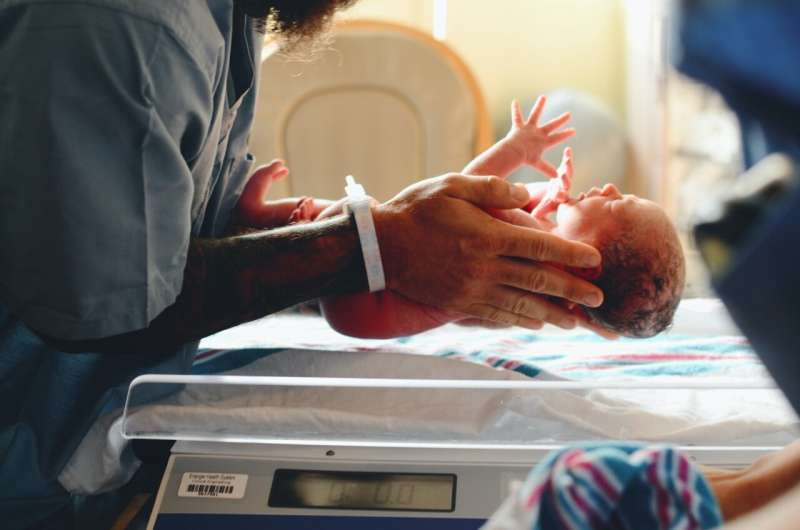This article has been reviewed according to Science X's editorial process and policies. Editors have highlighted the following attributes while ensuring the content's credibility:
fact-checked
peer-reviewed publication
trusted source
proofread
Study finds female babies with congenital diaphragmatic hernia have slightly higher risk of death

A Johns Hopkins Children Center study using medical records from an international registry concludes that female babies with congenital diaphragmatic hernia (CDH) are slightly more likely to die within 30 to 60 days of birth than male babies with the same condition.
In a report on the published June 19 in The Journal of Pediatrics, investigators examine the role biological sex plays in outcomes for patients with CDH, and they found that females have about a 32% higher risk of dying than males. The researchers say it's a small but significant difference, and that the origins are unclear but may be linked in part to overall lower birth weights for female newborns.
CDH, which Johns Hopkins experts say affects an estimated one in 4,000 live births annually in the United States, has a historically high mortality rate of 30% or more. Thought to be rooted in genetic alterations that affect organ development during pregnancy, the condition is marked by defects in formation of the diaphragm—a large muscle that separates the chest from the abdomen and that is vital to breathing. The developmental damage leaves a hole or rupture, in the muscle that allows the intestines, stomach, liver and other abdominal organs to protrude into the chest. Most significantly, it impairs an infant's normal lung development.
While some previous studies showed that male babies are more likely than female babies to have CDH, the impact of sex on a patient's survival has been unclear from other studies.
"Although racial and ethnic outcome disparities have been documented in CDH, disparities between males and females are not well known," says Shaun Kunisaki, M.D., M.Sc., a senior author of the study, professor of surgery at Johns Hopkins University, and director of the congenital diaphragmatic hernia program at the Children's Center. "It is really important to understand if those disparities exist, because it may change how we can better manage these patients."
In an effort to compare disease severity and analyze differences in survival between female and male patients, Kunisaki and J. Michael Collaco, M.D., Ph.D., M.S., an associate professor of pediatrics in the Eudowood Division of Pediatric Respiratory Sciences, turned to a large international registry—the Congenital Diaphragmatic Hernia Study Group. Developed by the University of Texas at Houston, the registry is comprised of data on 7,288 neonatal patients with CDH—41% female and 58% male. All of the data was gathered from January 2007 to December 2018 from 105 hospitals in 17 countries including the United States.
The researchers found that females, who weighed less on average at birth than males, had a lower survival rate at 30 days after birth: 77.3%, compared with males who had an 80.1% 30-day survival rate. At 60 days after birth, female patients had a 70.2% survival rate, compared with 74.2% for males.
"The sex differences in mortality rates is not huge," Kunisaki says. But, he adds, because death is such a catastrophic outcome, the finding has the potential to better guide interventions to prevent it.
One such intervention, Kunisaki says, is to raise awareness among physicians who care for people who are pregnant and newborns.
"It may be that we need to be more aggressive in treating female CDH patients than we currently are," explains Kunisaki. "That may mean using medications to optimize lung function, and developing different clinical criteria for placing female patients with CDH on ECMO, [a heart-lung machine] to protect their lungs."
Kunisaki also recently authored a separate study, published in JAMA Network Open, that used a different database to examine the impact of race and ethnicity on patients with CDH. The study found that hospitals treating a more racially and ethnically diverse patient population were associated with lower mortality for Black and Hispanic patients with CDH. There was no effect on mortality in white patients with CDH. He says findings from both of his studies represent a call to action for investigators to better understand disparities in vulnerable patient populations.
"Unfortunately, with sex, as well as race and ethnicity, we know disparities do exist," Kunisaki says. "Determining why—whether it's caused by biology or other aspects that can be modified—will be important in efforts to prevent them."
The investigators caution that further research is needed to confirm the current study's findings because of data collection limitations, such as diagnosis miscoding and missing data on patients in the registry.
Kunisaki and the team of investigators believe, however, their findings provide a roadmap for such research, and ultimately to better therapies.
More information: Shelby R. Sferra et al, Sex-Specific Differences in Congenital Diaphragmatic Hernia Mortality, The Journal of Pediatrics (2023). DOI: 10.1016/j.jpeds.2023.113481
Shelby R. Sferra et al, Racial and Ethnic Disparities in Outcomes Among Newborns with Congenital Diaphragmatic Hernia, JAMA Network Open (2023). DOI: 10.1001/jamanetworkopen.2023.10800

















